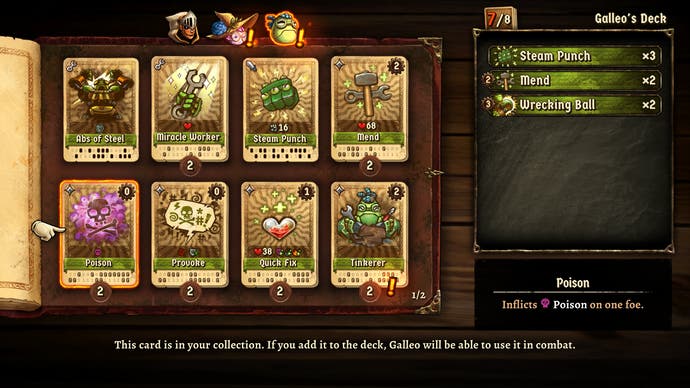SteamWorld Quest review - indie's mechanical masters triumph with yet another genre
Orik dangerous.
I am hopelessly in love with Orik. SteamWorld Quest has heroes instead of classes - a handful of lovable clanking misfits, each of whom bring their own decks and their own focus to the turn-based card battling that makes up the campaign. They're all brilliant. One of them hammers with massive fists and heals with boundless love. Another inflicts shrapnel wounds by literally pelting foes with money. Then there's Orik. Orik the elegant mystery man with the masks. He stands tall and straight, always, seemingly, attentive and yet easy - if that combination is possible. When he strikes, his rapier shifts from stance to stance, slicing baddies to courtly ribbons. The masks change as the moves change, each with its own bonus which lasts to the end of a turn. His deck takes a while to understand, but it is wonderfully brisk and wounding when you get your head around it. The word for Orik is decisive. His sense of poise gives me poise. He is never out of my line-up.
A card-battling RPG would have felt like a niche concern a while back, but Hearthstone happened, and then Slay the Spire and a dozen more. Do you need another of these games in your life? When it's from the SteamWorld team, yes you do, I think. SteamWorld games take an established genre and fill it with robots and palpable character. Previous entries have tackled platformers and turn-based tactics. This time we're in the robotic dark ages following a band of knockabout losers on a mission to prove themselves heroes. And they do that with cards.
Punchcards, because this is robots we're talking about. Selecting a team of three heroes - you can swap them out from a cheerful gaggle whenever you fancy - you rove around beautiful 2D environments taking in glades, grottoes, haunted libraries and the like, and you battle awful beasts and bullies as you work through the various chapters of a surprisingly long and involved campaign. Each hero - I mean this term in the loosest sense - has its own deck, which grows throughout the course of the game as you find new cards or craft them or even upgrade oldies with the materials you find lying around. Even from the off, though, they bring wonderfully distinct forms of righteous violence to each encounter.

In a move that reminds me of XCOM with its two-actions simplicity, each turn in combat sees you selecting three cards to either deal damage, buff or debuff, or heal. Each hero's cards are distinct and they'll all be pleasantly jumbled in your hand. Do you want something from the robot who specialises in flame and frost and electricity? Or do you want the one who sometimes wounds herself as she inflicts pain on her foes? The first layer of complexity comes with the mana system, which is called steam here. Some cards come with no steam cost, which means that actually allow you to build steam, one point for each card you play. Other cards with steam costs will slowly become available as you earn enough points to play them. Steam cost cards tend to be the most devastating, and so steam management was an early fixation of mine. Something bright and rewarding to focus on during starter battles, and to ponder after my first defeats.
But it's not the only thing. Taking a leaf from games like Poker, if you play your three cards from the same hero's deck, you'll be granted a fourth card as a chain move. God this is satisfying. Each character comes with their signature chain card - laying down extra damage, say, or healing the team, or granting everyone a shield, or even leeching health from the baddies. Chains can see you whittling enemies down in no time at all, and there's often a sharp pang of recrimination in the Donlan household if I fail to chain at every turn. But listen: you can be too fixated on chains, particularly since you can kill two cards and replace them each turn, a form of gambling as you wait for the right chain card to emerge, only to find out that it hasn't and you've thrown your best substitute offerings away waiting.
So you're encouraged to think in terms of combos, as with every other card battler, but also in terms of suits, which adds a wonderful element of complexity while also driving home the focus on character which defines the games that this team makes in the first place. Man, the characters are fantastic, the perfect fit for a campaign that centres on underdogs taking on a cruel world. Enemies aren't bad either. Plenty of dragons and ghouls and robotic monstrosities, but I also take my hat off to any game which gives the humble slime foe a health-regen move called "moisturise." Yuck.

Statuses, items, armour and treasure chests. All of this good stuff features, along with the odd puzzle and maze and a completion meter for each chapter which tells you when you haven't fully sounded out the map. SteamWorld Quest covers all its bases. But it also has a surprising pacing that I grew to love, offering fewer random battles than expected, but always against meaty foes. Every fight can feel a bit like a boss here, and the health system encourages you to take the challenge seriously, with Bonfire-style save points that allow you to refill your team's HP mid-chapter, but with the caveat that all nearby enemies will bounce back to life too.
I'll be totally honest. After Slay the Spire I thought I had the only card battling RPG I needed for the time being. But I should never bet against the SteamWorld team, and so it proved here. Wit, warmth, smart mechanics and a surprising challenge all make SteamWorld Quest a delight - and then there's Orik, of course.



